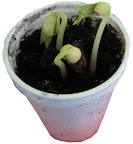Early childhood teachers respond to request for resources on Earth and Life Science
By Peggy Ashbrook
Posted on 2011-11-15

Children observe and document seasonal changes as they begin to learn how living organisms respond to their environment.
Do you have resources for early childhood teachers who are struggling to teach earth science or life science concepts? Especially for teachers who understand that young children need to be physically involved with their learning but not simply making a craft project to take home? Teachers who responded to this NSTA members’ email list request suggested:
•Young children really do well with observation techniques. Get them talking and discussing what they see using their senses. Make a chart with the senses and document verbiage they use in short words/phrases about an object/topic. Go outside and explore their environment with hand-lens, let them get their hands dirty. Let them bring items from home that would add to the discussion. Let them draw what they observe (this helps with fine motor coordination). Let them use a BROCK microscope, my first graders loved to take them out to recess. They are VERY durable. Make screens with varying grids to shake [sort] out dirt. ASK them what THEY want to learn about. Open the world of science for them and you’ll have life-long learners in no time! Graph [the number of] objects they bring in or find outside. Get them thinking what else could they use the object for. Have them draw/trace an object say, scissors, then have them draw them as something else. Deb Wilson, Retired Primary Teacher, Executive Director for STOM (Science Teachers of Missouri).
• Being able to use the outdoors as your classroom is a real plus. Humans begin to make sense of their world by using their 5 senses, so take advantage of investigating it, especially the tiny minute organisms. Most children are so ready to go outside…running, playing, etc., but how many children go outside to observe and investigate? I take a bag of science tools outside with me: hand lenses, binoculars, small “collection” jars, rulers, identification books, nature journals, pencils, and my camera. Encourage the children to “take in” the textures – tree bark, leaves, rocks, soil; the sights: get on their knees and look for tiny insects and bits of nature that have interesting color, shapes, texture, smells; look up in the trees and the sky; go on a listening walk and identify natural and man-made sounds; plant a small garden so the children can experience plant life cycles and the interdependence of plants and animals. If you have access to a digital microscope, bring some of the nature inside so your children can look even closer (see attachment). Hope this gives you some more ideas. The experiences that I am talking about can be enjoyed by all children. Asking leading inquiry based questions might result in projects. Gail Laubenthal, Pre-K teacher, Austin, Texas
• Here are some life science learning activities. Some may be considered “arts and crafts” because they are required to draw or assemble, but these are legitimate science (and motor) skills that young students need to learn. Describing and depicting what they observe is an early building block to later inquiry. Specific to elementary life science: camouflage as a selective advantage, animal behavior and observation and recording skills, studying pollination and seed dispersal adaptations, parts of the plant with a Plant Party and using Hidden Pictures to search for and name animals and plants that live in various habitats around the world. Sheri Amsel Science Coordinator, Exploring Nature Educational Resource, Wild Science Professional Development, www.exploringnature.org
Here are my two cents about these resources–a few books that I found especially helpful in teaching about life cycles and flower-fruit-seed formation in plants, and a rich discussion and listing of resources on an NSTA Learning Communities forum.
From Seed to Plant (Rookie Read About Science Series) by Alan Fowler. 2001. Childrens Press.
Nature Close-Ups: Seeds and Seedlings by Elaine Pascoe. 1999. Blackbirch Press.
Plant Secrets by Emily Goodman, illustrated by Phyllis L. Tildes. 2009. Charlesbridge.
Seeds by Ken Robbins. 2005. Atheneum Books.
Ten Seeds by Ruth Brown. 2001. Knopf Books.
And a couple about earth science concept of rock formation:
Materials, Materials, Materials: Rock by Chris Oxlade. 2002. Heinemann.
Rocks: Hard, Soft, Smooth, and Rough by Natalie M. Rosinsky. 2003. Picture Window Books.
See more resources on teaching earth science to young children, at the NSTA Learning Center Elementary Science forum, Earth Science Ideas for Kindergarten
Rock on! (groan) Peggy
Disclaimer: The views expressed in this blog post are those of the author(s) and do not necessarily reflect the official position of the National Science Teaching Association (NSTA).



